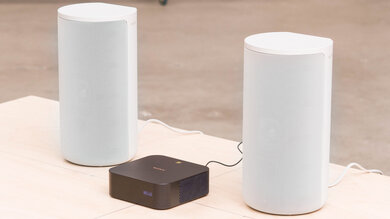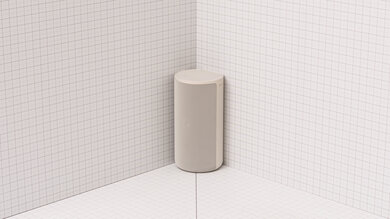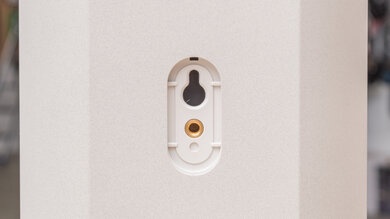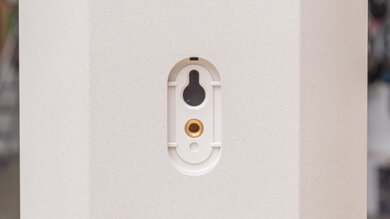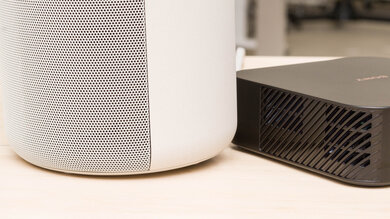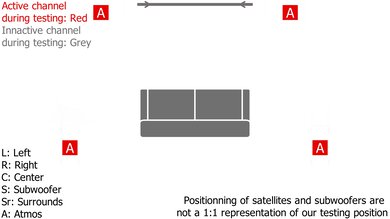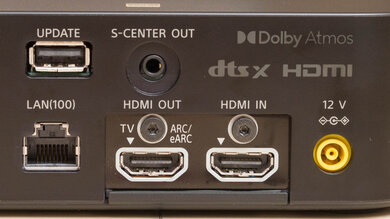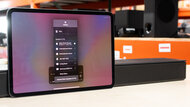The Sony HT-A9 is a premium setup with a very unique design. Instead of a wide soundbar, it comes with a small control box and four satellite speakers. Sony's 360 Spatial Sound technology is advertised to create a more immersive listening experience with a wide-sounding soundstage. It also has Sound Field Optimization to calibrate your setup based on your room's acoustics. It supports Atmos content, and it has a very immersive surround performance.
Note: You can upgrade the Sony HT-A9 with a subwoofer, which is sold separately. These results represent the standalone control box and satellites, but you can also see the results for the Sony HT-A9 with Bass Module.
Our Verdict
The Sony HT-A9 is satisfactory for mixed usage. This setup comes with a Sound Field Optimization room correction feature that optimizes audio reproduction based on your room's acoustics, which we turned on for our tests. It offers immersive surround and Atmos performances. While it struggles to reproduce a thumpy low-bass for bass-heavy music or action movies, it can still reproduce vocals and lead instruments pretty clearly. There's a little extra muddiness in the bass range, though, which may slightly thin out those same instruments. It also doesn't get very loud.
-
Room correction feature.
-
Fantastic soundstage.
-
Lacks low-bass.
-
Doesn't get very loud.
The Sony HT-A9 is decent for dialogue-centric content like TV shows. Thanks to its balanced mid-range, vocals are reproduced clearly and with detail, though they can also be thin. There's even a dialogue enhancement feature to make voices more clear and crisp. However, this setup lacks a discrete center channel, so voices seem to come from a more general area rather than an accurate, pinpoint location. That said, the manufacturer says that you can use compatible Sony TVs as a discrete center when paired to the setup.
-
Dialogue enhancement mode.
-
Phantom center channel.
The Sony HT-A9 is satisfactory for music. It has a Sound Field Optimization room correction feature that automatically calibrates audio reproduction based on your room's acoustics. On 'Standard Surround' mode, it reproduces vocals and lead instruments pretty clearly, though there's a little extra muddiness in the bass that may thin them out. Unfortunately, it can't reproduce the deep thump and rumble in bass-heavy genres like EDM. While there's a subwoofer level adjustment, it doesn't offer a lot of other sound customization options. Some of its sound features are also only available when using the full setup, like the subwoofer volume adjustment feature.
-
Subwoofer level adjustment.
-
Room correction feature.
-
Lacks low-bass.
-
No graphic EQ.
The Sony HT-A9 is decent for movies. On 'Standard Surround', it has a balanced mid-range that reproduces dialogue pretty clearly. Its four satellites offer an immersive surround sound experience, and you can also turn its up-firing speakers on and off using its Immersive AE feature. It also supports Dolby Atmos content. That said, it can't reproduce the deep rumble in action-packed scenes, and it doesn't get very loud.
-
Room correction feature.
-
Fantastic soundstage.
-
Lacks low-bass.
-
Doesn't get very loud.
- 7.4 Mixed Usage
- 7.2 Dialogue/TV Shows
- 7.5 Music
- 7.4 Movies
Changelog
-
Updated Jan 30, 2025:
We added a reference to the Sony BRAVIA Theater Quad in the Dimensions - Satellites box.
- Updated Jul 31, 2024: We've added a comparison between this soundbar and the Sony BRAVIA Theater Quad with Bass Module in Style- Satellites.
- Updated Sep 14, 2023: Updated text in Video Passthrough to TV box for clarity. No changes in test results.
- Updated Sep 11, 2023: Updating the bar to firmware version 1.779 adds ALLM and HDMI Forum support. The Video Passthrough to TV score improves from 9.0 to 9.5 as a result.
- Updated May 05, 2023: Updated Audio Format Support and Video Passthrough To TV results with new methodology.
Check Price
Differences Between Sizes And Variants
The Sony HT-A9 is available in 'Light Gray', and you can see the label for the model we tested here.
These results aren't valid for the full setup with the subwoofer, which is sold separately. You can also look at our results for the Sony HT-A9 with Bass Module.
If you come across another version of this soundbar, let us know in the discussions, and we'll update our review.
Popular Soundbars Comparisons
The Sony HT-A9 is a 4.0.4 setup with a very unique design. It has a small control box, four satellite speakers, and you can even upgrade it with a subwoofer sold separately. Its 360 Spatial Sound technology offers a very wide, immersive-sounding soundstage, so audio seems to be coming from all around you. However, it doesn't get very loud, and it can't reproduce a thumpy low-bass.
See our recommendations for the best soundbars, the best Sony soundbars, and the best Dolby Atmos soundbars.
The Sonos Arc is better than the Sony HT-A9. These setups have very different designs, as the Sonos is a long standalone bar while the Sony is a small box with four satellites. The Sonos reproduces a slightly more extended low-bass and has a better center channel performance. However, the Sony has a better soundstage. You can also upgrade both of these setups with subwoofers.
The Sony HT-A7000 and the Sony HT-A9 are both premium soundbars. These setups have very different designs, as the HT-A7000 is a long standalone bar while the HT-A9 is a small box with four satellites. The HT-A7000 is better built with a discrete center channel. However, the HT-A9 has better soundstage and Atmos performances.
The Bose Smart Soundbar 900 is better than the Sony HT-A9. The Bose is better built and gets louder. It also has a better center channel performance. However, the Sony soundbar has a better soundstage. Unlike the Bose, it comes with a Full HDMI In port for high-quality passthrough.
The Sony HT-A7000 with Speakers + Bass Module is better than the standalone Sony HT-A9. The HT-A7000 comes with a dedicated subwoofer that helps reproduce a more extended low-bass. It's better built, and it also has better center and surround performances. That said, the 4.0.4 HT-A9's unique design may be preferable for some users. It also offers better soundstage and Atmos performances. You can even upgrade the HT-A9 with a subwoofer if you prefer.
The Sonos Arc with Sub + One SL Speakers is better than the Sony HT-A9. The Sonos is a 5.1.2 setup that's better built and comes with a dedicated sub. It can reproduce a more extended low-bass, so you feel more thump and rumble in your audio. Also, it has better center and surround performances. That said, the Sony has better soundstage and Atmos performances. You can also add on a separate subwoofer if you want.
The Samsung HW-Q900A is better than the Sony HT-A9. The Samsung is a 7.1.4 setup with a dedicated subwoofer included. It can reproduce a more extended low-bass, and it gets louder. It also has a better center performance as well as more sound enhancement features like a graphic EQ. That said, the 4.0.4 Sony is still a very immersive setup. It has discrete satellites, and its soundstage, surround, and Atmos performances are better.
The Bose Smart Soundbar 900 with Speakers + Bass Module is better for most uses than the standalone Sony HT-A9. The Bose comes with a dedicated sub, and it can reproduce a more extended low-bass. It's also better built with better surrounds and center performances. That said, the Sony has better soundstage and Atmos performances. Unlike the Bose, it even has DTS support and a Full HDMI In for high quality passthrough. You can also upgrade it with a sub if you prefer.
The Sony BRAVIA Theater Quad is the successor to the Sony HT-A9. The newer model has flat, rectangular speakers rather than the HT-A9's cylindrical design. This makes the Theater Quad speakers easier to mount on walls or in tight areas, making the most immediate difference between them the design of the discrete speakers. Other than that, the systems perform very similarly.
The Sennheiser AMBEO Soundbar MAX and the Sony HT-A9 are two very different setups. The Sennheiser is a large standalone soundbar with a 5.1.4 setup. It can reproduce a more extended low-bass right out of the box, and it gets much louder. It also has a better center channel performance. That said, the Sony has a unique design with four speakers and a small control box. It has better soundstage, surround, and Atmos performances. You can even add on a subwoofer to improve its bass reproduction.
The JBL Bar 9.1 is better than the Sony HT-A9. The JBL is a 5.1.4 setup with a discrete subwoofer included. It can reproduce a more extended low-bass, so you feel more thump and rumble in your audio. It also has better center and surround performances. However, the 4.0.4 Sony has a much better soundstage, and its Atmos performance is better. You can also upgrade it with a sub, sold separately.
The Samsung HW-Q950A is better than the Sony HT-A9. The Samsung is an 11.1.4 setup with a dedicated sub that can reproduce a more extended low-bass. It gets louder, and it has better center and surround performances. It even has a graphic EQ for sound customization. However, the Sony is better built with a better soundstage. You can also upgrade it with a dedicated sub.
The Sony HT-A9 with Bass Module is better than the standalone Sony HT-A9. With the addition of a dedicated subwoofer, the full setup can reproduce a more extended low-bass. This also improves its surround and Atmos performances, meaning you can feel more thump and rumble in action-packed movies. That said, the subwoofer does add some compression at max volume compared to the standalone bar.
Video
Test Results
The Sony HT-A9 has a very unique design. It has a small black control box with rounded edges. The bar section of a traditional setup is replaced by the off-white front left and right speakers, which have metal grilles and plastic casing. You can distinguish these speakers from the satellites based on the markings on the bottom. 'FL' stands for front left speaker, and 'FR' stands for front right.
You can purchase a dedicated subwoofer from the manufacturer separately.
The Sony HTA9 has two satellite speakers. They're painted an off-white color and cased in an off-white colored plastic. There are also metal grilles to protect the drivers inside. The satellites have the same design as the front left and right speakers, but you can tell them apart based on the markings on the bottom. The rear left speaker is marked 'RL,' and the rear right speaker is marked 'RR.' Sadly, they lack the dual-function stand/mount design that comes with the speakers in the Sony BRAVIA Theater Quad with Bass Module.
The Sony HT-A9 has a uniquely small design, so its control box can easily fit between the legs of a TV stand. It also isn't very tall, so it shouldn't block your TV screen.
Note: The measurements above are for one speaker. There's also a control box that comes with the speakers. Its dimensions are 5.9" (15 cm) long x 5.9" (15 cm) wide x 1.9" (5 cm) tall.
The Sony HTA9's satellite speakers are rather tall when compared with the other models we've tested. Their footprint is also a little bigger than average. It shouldn't make much difference when placing them in your room, especially if you plan to put them on a stand, but if you're looking for satellites that are easier to wall mount, consider the Sony BRAVIA Theater Quad.
The Sony HT-A9 has a great build quality. The speakers have metal grilles that help protect the drivers inside. There's also a plastic casing with a slightly rough texture that feels quite solid. The control box is mostly made of plastic, though it can feel a bit cheap. It can also get hot when the setup is in use.
The Sony HT-A9 has a fair stereo frequency response. It comes with a Sound Optimization Feature that automatically calibrates audio reproduction based on the acoustic characteristics of your room. You can set it up once the bar connects to your TV. On 'Standard Surround' mode, it struggles to reproduce the deep thump and rumble in the low-bass. While vocals and lead instruments are reproduced pretty clearly, there's some extra muddiness in the high-bass that can slightly thin out those same instruments. There's also a subwoofer level adjustment to help you customize its sound, though you can only adjust the subwoofer volume when paired with the full setup.
We performed all our sound tests with the Sony HT-A9 set to 'Standard Surround' mode. During our subjective listening tests, we found that both 'Standard Surround' and 'Cinema' mode filled the room with sound and offered a solid listening experience. All channels seemed active, while the 'Music' preset seemed to only play audio from the front left and right speakers.
The Sony HT-A9 has a decent stereo frequency response with calibration. With the subwoofer level set to 'MAX', it struggles to reproduce the deep thump in bass-heavy music and action-packed movies. Its sound profile is still a bit muddy, which may slightly thin out vocals and lead instruments.
Note: The subwoofer adjustment feature offers three different levels: 'MIN', 'MID', and 'MAX'. 'MID' is its default setting, so we note it as '0' in our results. Subsequently, we denote 'MIN' as '-1' and 'MAX' as '1'.
The Sony HT-A9 has a fantastic stereo soundstage. The soundstage is perceived to be very wide, and you can easily customize the experience by adjusting the speakers' location and placement based on the room size. The focus is pretty good, although at times there are audible holes due to the lack of a true discrete center channel.
The Sony HT-A9 has a decent stereo dynamics performance. It doesn't get very loud, so it isn't suitable for filling up a large room or a crowded party. That said, there isn't a lot of compression when you push it to max volume.
The Sony HT-A9 has a good stereo THD performance. It falls within good limits at a normal listening volume, resulting in clean and pure audio reproduction. There's a slight jump in THD across the range when you push the bar to max volume. However, this shouldn't be too noticeable with real-life content.
The Sony HT-A9 has a fair center channel performance. It lacks a discrete center, so it uses its left and right channels to simulate a phantom center. Unfortunately, this doesn't localize voices as accurately as a discrete setup. Dialogue may seem to come from a more general area rather than a pinpoint location.
However, you can use Acoustic Center Sync to pair this setup with a compatible BRAVIA TV. This feature uses the TV speakers as a discrete center channel. In our subjective listening tests, we noticed this feature does a better job anchoring voices to a pinpoint location in the soundstage, meaning you can hear them clearly from anywhere in the room. However, it also seems to decrease the sound quality. Sound isn't quite as immersive, and the volume level between the bar and the TV seems to differ. Some users may prefer to not use the TV as a center channel to maintain better sound quality.
Update 10/21/2021: We updated the text to reflect that the Sony HT-A9 has a discrete surround setup.
The Sony HT-A9 has a decent surrounds performance. Thanks to its discrete setup, it can more accurately represent surround objects like voices in the sound image. Audio seems like it's coming from all around you, rather than just from speakers placed in front of you. In our subjective listening tests, we found that the bar offers a very immersive listening experience.
The Sony HT-A9 uses up-firing speakers to bounce sound off the ceiling and back down towards you to simulate height. While it doesn't seem as clear or real as a discrete setup found with home theater systems, it still offers a solid performance. In our subjective listening tests, we found that the room felt mostly full of sound. There are some noticeable holes in the sound image at times, but this is possibly due to the lack of a discrete center channel.
The Sony HT-A9 has an excellent selection of sound enhancement features. You can choose between several different EQ presets: 'Standard Surround', 'Cinema', 'Music', and 'Auto Sound'. There's also an Immersive AE feature that lets you turn the up-firing drivers on and off. However, you can't adjust this feature when watching Atmos content, as it's locked to the 'On' position. You can adjust the subwoofer level, but you can only adjust the subwoofer volume when paired to the full setup. Unfortunately, it lacks a full graphic EQ.
There's also a room correction feature called Sound Field Optimization. You can set up this feature once the soundbar connects to your TV. You can take a look at the setup process here.
The Sony HT-A9 has several physical inputs to choose from. There's a Full HDMI In port, meaning you can use it as a hub between different devices. There's also an S-Center Out port on the control box that lets you connect to a compatible BRAVIA TV for enhanced audio playback.
The Sony HT-A9 has incredible audio format support via ARC. It can playback common surround sound formats like Dolby Digital, often found on Blu-rays and streaming platforms. It also supports eARC, and it can playback lossless and object-based formats like Dolby Atmos.
The Sony HT-A9 can playback common surround sound formats like Dolby Digital via Full HDMI In. It also supports lossless and object-based formats like Dolby Atmos and DTS:X.
The Sony HT-A9 has a good latency performance. It has fairly low latency via ARC and Full HDMI In, so you shouldn't notice a delay between the audio you hear and the video you see. That said, some apps and TVs compensate for latency differently, so your real-world experience can vary. The manufacturer also says that its A/V SYNC feature can help with synchronization. You can activate it in the app.
This soundbar can passthrough many common resolutions and refresh rates, which is great if you want to use it as a hub between devices like a TV and a PC. Updating the bar to firmware version 1.779 adds support for HDMI Forum VRR and ALLM. Plus, this bar supports HDMI version 2.1, which offers a higher bandwidth than the traditional HDMI version 2.0. As a result, the bar can passthrough 4k @ 120Hz @ 10-bit and 4k @ 4:4:4 @ 120Hz content that you find on certain gaming platforms.
The Sony HT-A9 lets you wirelessly stream audio from your mobile devices over many different connections. We noticed the sound would pop in and out when connected over Bluetooth and Apple AirPlay in our tests. However, you may not encounter this at home, as we tend to have quite a few wireless devices active at any given time in our testing space. Let us know if you experience similar issues in the forums below.
The Sony HT-A9 doesn't have built-in voice assistant support. If you want to control it with your voice, you need to pair it to a third-party device with voice assistant capabilities. According to the manufacturer, it can support Google Assistant-enabled devices.
Comments
Sony HT-A9: Main Discussion
Let us know why you want us to review the product here, or encourage others to vote for this product.
Update: We added a reference to the Sony BRAVIA Theater Quad in the Dimensions - Satellites box.



